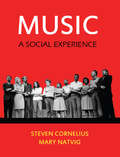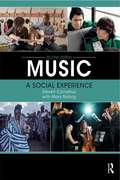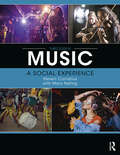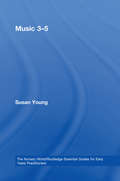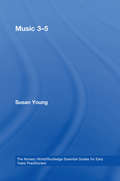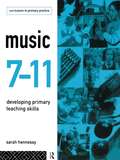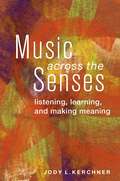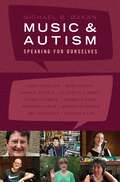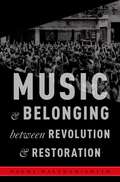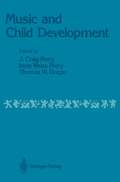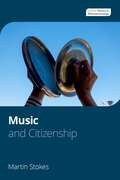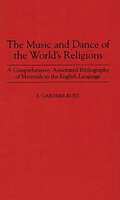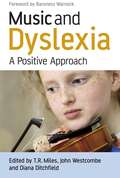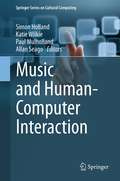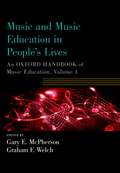- Table View
- List View
Music: A Social Experience
by Steven Cornelius Mary NatvigMusic: A Social Experience offers a topical approach for a music appreciation course. Through a series of subjects–from Music and Worship to Music and War and Music and Gender–the authors present active listening experiences for students to experience music's social and cultural impact. The book offers an introduction to the standard concert repertoire, but also gives equal treatment to world music, rock and popular music, and jazz, to give students a thorough introduction to today's rich musical world. Through lively narratives and innovative activities, the student is given the tools to form a personal appreciation and understanding of the power of music. The book is paired with MySearchLab, featuring listening guides with streaming audio, short texts on special topics, and sample recordings and notation to illustrate basic concepts in music.
Music: A Social Experience
by Steven Cornelius Mary NatvigBy taking a thematic approach to the study of music appreciation, Music: A Social Experience, Second Edition demonstrates how music reflects and deepens both individual and cultural understandings. Musical examples are presented within universally experienced social frameworks (ethnicity, gender, spirituality, love, and more) to help students understand how music reflects and advances human experience. Students engage with multiple genres (Western art music, popular music, and world music) through lively narratives and innovative activities. A companion website features streaming audio and instructors' resources. New to this edition: Two additional chapters: "Music and the Life Cycle" and "Music and Technology" Essay questions and "key terms" lists at the ends of chapters Additional repertoire and listening guides covering all historical periods of Western art music Expanded instructors’ resources Many additional images Updated student web materials
Music: A Social Experience
by Steven Cornelius Mary NatvigBy taking a thematic approach to the study of music appreciation, Music: A Social Experience, Second Edition demonstrates how music reflects and deepens both individual and cultural understandings. Musical examples are presented within universally experienced social frameworks (ethnicity, gender, spirituality, love, and more) to help students understand how music reflects and advances human experience. Students engage with multiple genres (Western art music, popular music, and world music) through lively narratives and innovative activities. A companion website features streaming audio and instructors' resources. New to this edition: Two additional chapters: "Music and the Life Cycle" and "Music and Technology" Essay questions and "key terms" lists at the ends of chapters Additional repertoire and listening guides covering all historical periods of Western art music Expanded instructors’ resources Many additional images Updated student web materials Visit the companion website: www.routledge.com/cw/cornelius
Music: A Social Experience
by Steven Cornelius Mary NatvigBy taking a thematic approach to the study of music appreciation, Music: A Social Experience, Third Edition demonstrates how music reflects and deepens both individual and cultural understandings. Musical examples are presented within universally experienced social frameworks (ethnicity, gender, spirituality, love, and more) to help students understand how music reflects and advances human experience. Students engage with multiple genres (Western art music, popular music, and world music) through lively narratives and innovative activities. A companion website features streaming audio and instructors' resources. The third edition includes: A chapter on Black American music A revised and developed chapter on gender and sexuality A dozen additional Listening Guides, with an emphasis on contemporary popular music Over 100 new full-color images Updated teacher and student resources on the book’s companion website Expanded content throughout, highlighting the social, cultural, and technological changes since publication of the previous edition The culmination of thirty years of experimentation in the music appreciation classroom, this third edition of Music: A Social Experience continues to empower lifelong musical learning by engaging students and readers on their own terms.
Music 3-5
by Susan YoungThis book gives information, ideas and principles for music with three to five year olds that are both down-to-earth and up-to-date. Written in a style which is engaging and readable, it integrates recent theory and practice illustrating the discussion with examples and ideas taken from real life. Chapters in this inspiring and engaging book show practitioners how to: connect with the educational concepts and principles of using music in early years settings recognise and understand children's musical starting points foster creativity through music support listening and communication through music learn the key areas of listening, singing, using instruments and dancing develop children's musical understanding widen opportunities for music through resources, new technologies and visiting artist projects. Early years practitioners and students will find this a valuable introduction to music with young children. More experienced practitioners will find the contemporary ideas a source of inspiration. Books in this series address key issues for early years practitioners working in today's Foundation Stage environments. Each title is packed full of practical activities, support, advice and guidance, all of which is in line with current government early years policy. The authors use their experience and expertise to write accessibly and informatively, emphasising through the use of case studies the practical aspects of the subject, whilst retaining strong theoretical underpinnings throughout.
Music 3-5 (Essential Guides for Early Years Practitioners)
by Susan YoungThis book gives information, ideas and principles for music with three to five year olds that are both down-to-earth and up-to-date. Written in a style which is engaging and readable, it integrates recent theory and practice illustrating the discussion with examples and ideas taken from real life. Chapters in this inspiring and engaging book show practitioners how to: connect with the educational concepts and principles of using music in early years settings recognise and understand children’s musical starting points foster creativity through music support listening and communication through music learn the key areas of listening, singing, using instruments and dancing develop children’s musical understanding widen opportunities for music through resources, new technologies and visiting artist projects. Early years practitioners and students will find this a valuable introduction to music with young children. More experienced practitioners will find the contemporary ideas a source of inspiration. Books in this series address key issues for early years practitioners working in today’s Foundation Stage environments. Each title is packed full of practical activities, support, advice and guidance, all of which is in line with current government early years policy. The authors use their experience and expertise to write accessibly and informatively, emphasising through the use of case studies the practical aspects of the subject, whilst retaining strong theoretical underpinnings throughout.
Music 3-5 (Essential Guides for Early Years Practitioners)
by Susan YoungThis book gives information, ideas and principles for music with three to five year olds that are both down-to-earth and up-to-date. Written in a style which is engaging and readable, it integrates recent theory and practice illustrating the discussion with examples and ideas taken from real life. Chapters in this inspiring and engaging book show practitioners how to: connect with the educational concepts and principles of using music in early years settings recognise and understand children’s musical starting points foster creativity through music support listening and communication through music learn the key areas of listening, singing, using instruments and dancing develop children’s musical understanding widen opportunities for music through resources, new technologies and visiting artist projects. Early years practitioners and students will find this a valuable introduction to music with young children. More experienced practitioners will find the contemporary ideas a source of inspiration. Books in this series address key issues for early years practitioners working in today’s Foundation Stage environments. Each title is packed full of practical activities, support, advice and guidance, all of which is in line with current government early years policy. The authors use their experience and expertise to write accessibly and informatively, emphasising through the use of case studies the practical aspects of the subject, whilst retaining strong theoretical underpinnings throughout.
Music 3-5 (PDF)
by Susan YoungThis book gives information, ideas and principles for music with three to five year olds that are both down-to-earth and up-to-date. Written in a style which is engaging and readable, it integrates recent theory and practice illustrating the discussion with examples and ideas taken from real life. Chapters in this inspiring and engaging book show practitioners how to: connect with the educational concepts and principles of using music in early years settings recognise and understand children's musical starting points foster creativity through music support listening and communication through music learn the key areas of listening, singing, using instruments and dancing develop children's musical understanding widen opportunities for music through resources, new technologies and visiting artist projects. Early years practitioners and students will find this a valuable introduction to music with young children. More experienced practitioners will find the contemporary ideas a source of inspiration. Books in this series address key issues for early years practitioners working in today's Foundation Stage environments. Each title is packed full of practical activities, support, advice and guidance, all of which is in line with current government early years policy. The authors use their experience and expertise to write accessibly and informatively, emphasising through the use of case studies the practical aspects of the subject, whilst retaining strong theoretical underpinnings throughout.
Music 7-11: Developing Primary Teaching Skills
by Sarah HennessyTeachers have often felt unnecessarily apprehensive about teaching without music without being gifted musicians themselves.Music 7-11 dispels the myth that to teach music effectively a teacher has to "be musical" and provides teachers with the opportunity of developing both the basic subject knowledge and the confidence needed to deliver enjoyable and valuable music lessons. It does this by encouraging practical engagement with the subject through making and listening to music, reflecting on experiences and sharing views.
Music 7-11: Developing Primary Teaching Skills
by Sarah HennessyTeachers have often felt unnecessarily apprehensive about teaching without music without being gifted musicians themselves.Music 7-11 dispels the myth that to teach music effectively a teacher has to "be musical" and provides teachers with the opportunity of developing both the basic subject knowledge and the confidence needed to deliver enjoyable and valuable music lessons. It does this by encouraging practical engagement with the subject through making and listening to music, reflecting on experiences and sharing views.
Music Across the Senses: Listening, Learning, and Making Meaning
by Jody L. KerchnerMusic Across the Senses provides music educators with practical ideas for facilitating student music listening skill development. Written both for in-service and pre-service music educators, the book shows how to facilitate PK-12 students' listening skills using multisensory means in general music and performance ensemble classes. As a whole, Music Across the Senses helps teachers enable students to learn how to devise independent strategies for listening that they can employ and enjoy both now and throughout their lives.
Music Across the Senses: Listening, Learning, and Making Meaning
by Jody L. KerchnerMusic Across the Senses provides music educators with practical ideas for facilitating student music listening skill development. Written both for in-service and pre-service music educators, the book shows how to facilitate PK-12 students' listening skills using multisensory means in general music and performance ensemble classes. As a whole, Music Across the Senses helps teachers enable students to learn how to devise independent strategies for listening that they can employ and enjoy both now and throughout their lives.
Music and Autism: Conversations on Life, Music, and Autism
by Michael B. BakanSince the advent of autism as a diagnosed condition in the 1940s, the importance of music in the lives of autistic people has been widely observed and studied. Articles on musical savants, extraordinary feats of musical memory, unusually high rates of absolute or "perfect" pitch, and the effectiveness of music-based therapies abound in the autism literature. Meanwhile, music scholars and historians have posited autism-centered explanatory models to account for the unique musical artistry of everyone from Béla Bartók and Glenn Gould to "Blind Tom" Wiggins. Given the great deal of attention paid to music and autism, it is surprising to discover that autistic people have rarely been asked to account for how they themselves make and experience music or why it matters to them that they do. In Speaking for Ourselves, renowned ethnomusicologist Michael Bakan does just that, engaging in deep conversations--some spanning the course of years--with ten fascinating and very different individuals who share two basic things in common: an autism spectrum diagnosis and a life in which music plays a central part. These conversations offer profound insights into the intricacies and intersections of music, autism, neurodiversity, and life in general, not from an autistic point of view, but rather from many different autistic points of view. They invite readers to partake of a rich tapestry of words, ideas, images, and musical sounds that speak to both the diversity of autistic experience and the common humanity we all share.
Music and Autism: Conversations on Life, Music, and Autism
by Michael B. BakanSince the advent of autism as a diagnosed condition in the 1940s, the importance of music in the lives of autistic people has been widely observed and studied. Articles on musical savants, extraordinary feats of musical memory, unusually high rates of absolute or "perfect" pitch, and the effectiveness of music-based therapies abound in the autism literature. Meanwhile, music scholars and historians have posited autism-centered explanatory models to account for the unique musical artistry of everyone from Béla Bartók and Glenn Gould to "Blind Tom" Wiggins. Given the great deal of attention paid to music and autism, it is surprising to discover that autistic people have rarely been asked to account for how they themselves make and experience music or why it matters to them that they do. In Speaking for Ourselves, renowned ethnomusicologist Michael Bakan does just that, engaging in deep conversations--some spanning the course of years--with ten fascinating and very different individuals who share two basic things in common: an autism spectrum diagnosis and a life in which music plays a central part. These conversations offer profound insights into the intricacies and intersections of music, autism, neurodiversity, and life in general, not from an autistic point of view, but rather from many different autistic points of view. They invite readers to partake of a rich tapestry of words, ideas, images, and musical sounds that speak to both the diversity of autistic experience and the common humanity we all share.
Music and Belonging Between Revolution and Restoration (Critical Conjunctures in Music and Sound)
by Naomi Waltham-SmithIn what ways is music implicated in the politics of belonging? How is the proper at stake in listening? What role does the ear play in forming a sense of community? Music and Belonging argues that music, at the level of style and form, produces certain modes of listening that in turn reveal the conditions of belonging. Specifically, listening shows the intimacy between two senses of belonging: belonging to a community is predicated on the possession of a particular property or capacity. Somewhat counter-intuitively, Waltham-Smith suggests that this relation between belonging-as-membership and belonging-as-ownership manifests itself with particular clarity and rigor at the very heart of the Austro-German canon, in the instrumental music of Haydn, Mozart, and Beethoven. Music and Belonging provocatively brings recent European philosophy into contact with the renewed music-theoretical interest in Formenlehre, presenting close analyses to show how we might return to this much-discussed repertoire to mine it for fresh insights. The book's theoretical landscape offers a radical update to Adornian-inspired scholarship, working through debates over relationality, community, and friendship between Derrida, Nancy, Agamben, Badiou, and Malabou. Borrowing the deconstructive strategies of closely reading canonical texts to the point of their unraveling, the book teases out a new politics of listening from processes of repetition and liquidation, from harmonic suppressions and even from trills. What emerges is the enduring political significance of listening to this music in an era of heightened social exclusion under neoliberalism.
Music and Belonging Between Revolution and Restoration (Critical Conjunctures in Music and Sound)
by Naomi Waltham-SmithIn what ways is music implicated in the politics of belonging? How is the proper at stake in listening? What role does the ear play in forming a sense of community? Music and Belonging argues that music, at the level of style and form, produces certain modes of listening that in turn reveal the conditions of belonging. Specifically, listening shows the intimacy between two senses of belonging: belonging to a community is predicated on the possession of a particular property or capacity. Somewhat counter-intuitively, Waltham-Smith suggests that this relation between belonging-as-membership and belonging-as-ownership manifests itself with particular clarity and rigor at the very heart of the Austro-German canon, in the instrumental music of Haydn, Mozart, and Beethoven. Music and Belonging provocatively brings recent European philosophy into contact with the renewed music-theoretical interest in Formenlehre, presenting close analyses to show how we might return to this much-discussed repertoire to mine it for fresh insights. The book's theoretical landscape offers a radical update to Adornian-inspired scholarship, working through debates over relationality, community, and friendship between Derrida, Nancy, Agamben, Badiou, and Malabou. Borrowing the deconstructive strategies of closely reading canonical texts to the point of their unraveling, the book teases out a new politics of listening from processes of repetition and liquidation, from harmonic suppressions and even from trills. What emerges is the enduring political significance of listening to this music in an era of heightened social exclusion under neoliberalism.
Music and Child Development
by Irene WeissPeery J. CraigPeery Thomas W. DraperI acknowledge a deep debt of gratitude to my coeditors: my wife Irene, and my friend and colleague Tom Draper. They have worked with diligence and insight to bring this work to completion. They have delegated the task of writing the Preface to me. As the scientific study of human development matures it is not only natural, but it is necessary to reach beyond understanding the ways humans develop capacities, to study the ways emerging capacities fit into the larger sphere of human undertakings. Music is one of the most significant of those endeavors. As I attend the several piano competitions that are on my agenda each year, and see children seated at the keyboard drawing forth the magnificent sounds of Bach, Chopin, and Ravel, I am always a little awed. Surely, it seems to me, the piano* is among the best of man's creations; the creative energies of great composers are among mankind's greatest expressions; and encouraging children to associate themselves seriously with both instrument and composer can be one of the great blessings to their young lives and, by association, to the larger society. Music touches the entire range of our lifespan on a daily basis. Involving chil dren with music and music training has high market, and common sense, validity. Parents understand intuitively that children will benefit, and their lives will be enriched, if they are influenced by music and music training.
Music and Circle Time: Using Music, Rhythm, Rhyme and Song (PDF)
by Claire Wilkinson Margaret CollinsVisit the author's own website here! ' The book shows you how to confidently intergrate music into circle time and will be a useful addition to many teachers' resources'-Early Years Update '[A]n excellent resource for all teachers looking to introduce music to children aged from four to seven-years-old... The instructions are clear and precise, making it easy to use... an invaluable resource for all busy practitioners' - Early Years Educator 'The book is packed with ideas and the simple format makes it easy to use. Many of the suggestions can be used straight from the book or easily adapted to fit the interests of your own class... The book shows you how to confidently integrate music into circle time and will be a useful addition to many teachers' resources' - Early Years Update In the same popular and accessible style as Margaret Collins' established and successful Circle Time series, this book provides user-friendly classroom activities to engage young children. It uses Circle Time techniques to help children use and learn about: o rhythm, jingles, raps and chants o songs o instruments o ring games o music, art and story projects. The enjoyable activities can also enhance learning of other aspects of the curriculum. There is evidence that children who are familiar with a wide ranging repertoire of rhymes and songs learn to read earlier. Using this book all teachers will be able to use music in their Circle Time sessions in a confident and creative manner. Margaret Collins is a former headteacher of infant and first schools. She is now Senior Visiting Fellow in the School of Education at the University of Southampton. She researches children's perceptions of health education topics, writes teaching materials for children, books and articles on PSHE.
Music and Citizenship (Oxford Theory in Ethnomusicology)
by Martin StokesCritical citizenship practices and the language of today's populism have never been more sharply opposed. Today's insistent efforts to anchor citizenship narratives in national belonging now confront a variety of 'flexible' or 'differentiated' citizenships - plural, performative, and decentered practices of rights claiming mutually defining 'the political', its subjects, and its others on a variety of scales. They confront, too, critiques of citizenship in totalitarian or neoliberal governmentality that derive from Foucault, Agamben, and Arendt and have become pressing today in proliferating states of emergency and exception and the growing ranks of non-citizens. How should these debates be configured now? And what place does music have in them? In Music and Citizenship, author Martin Stokes argues that music has for a long time been entangled with debates about citizenship and citizenly identities, though for various reasons this entanglement has been insufficiently recognized. Citizenship and citizenly identity debates, for their part, have important implications for the way we think about music in relation to politics, identity, and scholarly practice. Stokes's particular claim is that ethnomusicology has for too long configured relationships between music, society, and reflective and critical practice in terms of identity paradigms. The rejection of these identity paradigms in recent years has taken the form of a post- or anti-humanism that is equally problematic. This book challenges the conventional understanding of citizenship in terms of nationalism and national identity though the examination of case studies from across Latin America, Africa, Asia, and Europe. In this way, this volume departs from an earlier ethnomusicology preoccupied with belonging and cultural participation in the nation-state. Citizenship-the fantasy, according to some definitions, of political community without outsiders-suggests, in this book, a different space in which one might configure such relations, one more satisfactorily, and energetically, oriented to questions about musical ecology, sustainability, democracy, and inclusivity.
Music and Citizenship (Oxford Theory in Ethnomusicology)
by Martin StokesCritical citizenship practices and the language of today's populism have never been more sharply opposed. Today's insistent efforts to anchor citizenship narratives in national belonging now confront a variety of 'flexible' or 'differentiated' citizenships - plural, performative, and decentered practices of rights claiming mutually defining 'the political', its subjects, and its others on a variety of scales. They confront, too, critiques of citizenship in totalitarian or neoliberal governmentality that derive from Foucault, Agamben, and Arendt and have become pressing today in proliferating states of emergency and exception and the growing ranks of non-citizens. How should these debates be configured now? And what place does music have in them? In Music and Citizenship, author Martin Stokes argues that music has for a long time been entangled with debates about citizenship and citizenly identities, though for various reasons this entanglement has been insufficiently recognized. Citizenship and citizenly identity debates, for their part, have important implications for the way we think about music in relation to politics, identity, and scholarly practice. Stokes's particular claim is that ethnomusicology has for too long configured relationships between music, society, and reflective and critical practice in terms of identity paradigms. The rejection of these identity paradigms in recent years has taken the form of a post- or anti-humanism that is equally problematic. This book challenges the conventional understanding of citizenship in terms of nationalism and national identity though the examination of case studies from across Latin America, Africa, Asia, and Europe. In this way, this volume departs from an earlier ethnomusicology preoccupied with belonging and cultural participation in the nation-state. Citizenship-the fantasy, according to some definitions, of political community without outsiders-suggests, in this book, a different space in which one might configure such relations, one more satisfactorily, and energetically, oriented to questions about musical ecology, sustainability, democracy, and inclusivity.
The Music and Dance of the World's Religions: A Comprehensive, Annotated Bibliography of Materials in the English Language (Music Reference Collection)
by E. RustDespite the world-wide association of music and dance with religion, this is the first full-length study of the subject from a global perspective. The work consists of 3,816 references divided among 37 chapters. It covers tribal, regional, and global religions and such subjects as shamanism, liturgical dance, healing, and the relationship of music, mathematics, and mysticism. The referenced materials display such diverse approaches as analysis of music and dance, description of context, direct experience, observation, and speculation. The references address topics from such disciplines as sociology, anthropology, history, linguistics, musicology, ethnomusicology, theology, medicine, semiotics, and computer technology.Chapter 1 consists of general references to religious music and dance. The remaining 36 chapters are organized according to major geographical areas. Most chapters begin with general reference works and bibliographies, then continue with topics specific to the region or religion. This book will be of use to anyone with an interest in music, dance, religion, or culture.
Music and Dyslexia: A Positive Approach
by T. R. Miles John Westcombe Diana DitchfieldMusic and dyslexia is of particular interest for two reasons. Firstly, research suggests that music education can benefit young dyslexics as it helps them focus on auditory and motor timing skills and highlights the rhythms of language. Secondly, dyslexic musicians at a more advanced level face particular challenges such as sight-reading, written requirements of music examinations and extreme performance nerves. This is a sequel to the highly successful Music and Dyslexia: Opening New Doors, published in 2001. The field of dyslexia has developed rapidly, particularly in the area of neuropsychology. Therefore this book focuses on these research advances, and draws out the aspects of music education that benefit young dyslexics. The contributors also discuss the problems that dyslexic musicians face, and several chapters are devoted to sight-reading and specific strategies that dyslexics can use to help them sight-read. The book offers practical techniques and strategies, to teachers and parents to help them work with young dyslexics and dyslexic musicians.
Music and Human-Computer Interaction (Springer Series on Cultural Computing)
by Simon Holland, Katie Wilkie, Paul Mulholland and Allan SeagoThis agenda-setting book presents state of the art research in Music and Human-Computer Interaction (also known as ‘Music Interaction’). Music Interaction research is at an exciting and formative stage. Topics discussed include interactive music systems, digital and virtual musical instruments, theories, methodologies and technologies for Music Interaction. Musical activities covered include composition, performance, improvisation, analysis, live coding, and collaborative music making. Innovative approaches to existing musical activities are explored, as well as tools that make new kinds of musical activity possible. Music and Human-Computer Interaction is stimulating reading for professionals and enthusiasts alike: researchers, musicians, interactive music system designers, music software developers, educators, and those seeking deeper involvement in music interaction. It presents the very latest research, discusses fundamental ideas, and identifies key issues and directions for future work.
Music and Music Education in People's Lives: An Oxford Handbook of Music Education, Volume 1 (Oxford Handbooks)
by Gary E. McPherson and Graham F. WelchMusic and Music Education in People's Lives is one of five paperback books derived from the foundational two-volume Oxford Handbook of Music Education. Designed for music teachers, students, and scholars of music education, as well as educational administrators and policy makers, this first book in the set provides a framework for understanding the content and context of music education, and for future action within the profession. A broad examination of the philosophical, psychological, cultural, international, and contextual issues that underpin a wide variety of teaching environments or individual attributes is paired with 25 relevant and insightful commentaries from established scholars and music educators. Taken as a whole, Music and Music Education in People's Lives gives clear direction to how the discipline of music education can achieve even greater political, theoretical and professional strength. Contributors Harold F. Abeles, Nick Beach, Wayne D. Bowman, Liora Bresler, Patricia Shehan Campbell, Richard Colwell, Robert A. Cutietta, David J. Elliott, Sergio Figueiredo, Lucy Green, Wilfried Gruhn, David Hargreaves, Sarah Hennessy, Liane Hentschke, Donald A. Hodges, Christopher M. Johnson, Estelle R. Jorgensen, Andreas C. Lehmann, Richard Letts, Håkan Lundström, Raymond MacDonald, Clifford K. Madsen, Andrew J. Martin, Marie McCarthy, Katrina McFerran, Gary E. McPherson, Bradley Merrick, Dorothy Miell, Graça Mota, Bruno Nettl, Bengt Olsson, Susan A. O'Neill, Johnmarshall Reeve, Bennett Reimer, James Renwick, Huib Schippers, Wendy L. Sims, David J. Teachout, Rena Upitis, Peter R. Webster, Graham F. Welch, Paul Woodford
Music and Music Education in People's Lives: An Oxford Handbook of Music Education, Volume 1 (Oxford Handbooks)
Music and Music Education in People's Lives is one of five paperback books derived from the foundational two-volume Oxford Handbook of Music Education. Designed for music teachers, students, and scholars of music education, as well as educational administrators and policy makers, this first book in the set provides a framework for understanding the content and context of music education, and for future action within the profession. A broad examination of the philosophical, psychological, cultural, international, and contextual issues that underpin a wide variety of teaching environments or individual attributes is paired with 25 relevant and insightful commentaries from established scholars and music educators. Taken as a whole, Music and Music Education in People's Lives gives clear direction to how the discipline of music education can achieve even greater political, theoretical and professional strength. Contributors Harold F. Abeles, Nick Beach, Wayne D. Bowman, Liora Bresler, Patricia Shehan Campbell, Richard Colwell, Robert A. Cutietta, David J. Elliott, Sergio Figueiredo, Lucy Green, Wilfried Gruhn, David Hargreaves, Sarah Hennessy, Liane Hentschke, Donald A. Hodges, Christopher M. Johnson, Estelle R. Jorgensen, Andreas C. Lehmann, Richard Letts, Håkan Lundström, Raymond MacDonald, Clifford K. Madsen, Andrew J. Martin, Marie McCarthy, Katrina McFerran, Gary E. McPherson, Bradley Merrick, Dorothy Miell, Graça Mota, Bruno Nettl, Bengt Olsson, Susan A. O'Neill, Johnmarshall Reeve, Bennett Reimer, James Renwick, Huib Schippers, Wendy L. Sims, David J. Teachout, Rena Upitis, Peter R. Webster, Graham F. Welch, Paul Woodford
